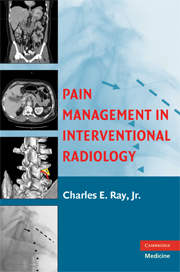Book contents
- Frontmatter
- Contents
- Contributors
- Preface
- Acknowledgments
- 1 Pain Management in Interventional Radiology: An Introduction
- 2 Clinical Evaluation of Low-Back Pain
- PART I LOCOREGIONAL PAIN CONTROL
- 3 Local Anesthetics
- 4 Functional Lumbar Spine Anatomy: A Review
- 5 Percutaneous Vertebroplasty
- 6 Kyphoplasty
- 7 Epidural Steroid Injections
- 8 Selective Nerve Root Blocks
- 9 Discography
- 10 Facet (Zygapophyseal) Joint Injections
- 11 Articular Interventions in Pain Management: A General Approach
- 12 Percutaneous Management of Visceral Pain
- 13 Embolization of Painful Neoplasms
- 14 Image-Guided Ablation of Painful Osteolyses
- 15 Chronic Pelvic Pain in Women
- PART II SYSTEMIC PAIN CONTROL
- Index
- References
10 - Facet (Zygapophyseal) Joint Injections
from PART I - LOCOREGIONAL PAIN CONTROL
Published online by Cambridge University Press: 04 September 2009
- Frontmatter
- Contents
- Contributors
- Preface
- Acknowledgments
- 1 Pain Management in Interventional Radiology: An Introduction
- 2 Clinical Evaluation of Low-Back Pain
- PART I LOCOREGIONAL PAIN CONTROL
- 3 Local Anesthetics
- 4 Functional Lumbar Spine Anatomy: A Review
- 5 Percutaneous Vertebroplasty
- 6 Kyphoplasty
- 7 Epidural Steroid Injections
- 8 Selective Nerve Root Blocks
- 9 Discography
- 10 Facet (Zygapophyseal) Joint Injections
- 11 Articular Interventions in Pain Management: A General Approach
- 12 Percutaneous Management of Visceral Pain
- 13 Embolization of Painful Neoplasms
- 14 Image-Guided Ablation of Painful Osteolyses
- 15 Chronic Pelvic Pain in Women
- PART II SYSTEMIC PAIN CONTROL
- Index
- References
Summary
INTRODUCTION
Back pain due to the many causes is a significant health issue in this country. The annual incidence of lower back pain is at least 5% (1). It affects men and women equally, most often between 30 and 50 years of age. About 85% of patients with isolated back pain cannot be given a diagnosis (2). Finding an association between imaging findings and symptoms is usually difficult or, at times, impossible (1,3).
Given the prevalence of back pain, therapies and interventions treating such processes represent a growing segment of health care spending. For example, spinal injection procedures have expanded significantly since the mid- to late 1990s. The volume of facet joint injections has almost tripled and reimbursements have followed the same trend. The provider profile has changed as well, with anesthesiologists performing the majority of procedures and radiologists share of procedures declining from 1993 to 1999 (4).
Chronic low-back pain is defined as pain persisting longer than three months. Most monotherapies (e.g., analgesics, nonsteroidal anti-inflammatory drugs, muscle relaxants, antidepressants) do not work or have limited efficacy for chronic low-back pain (2). Facet joint pain is thought to be a significant cause of otherwise unexplained chronic low-back pain. In the group of chronic low-back pain patients for whom conventional investigations do not identify a cause of pain, facet joint pain can be diagnosed by facet injections with local anesthetic in 15–40% of patients (5).
Therapy for facet joint pain remains somewhat controversial.
- Type
- Chapter
- Information
- Pain Management in Interventional Radiology , pp. 151 - 163Publisher: Cambridge University PressPrint publication year: 2008



